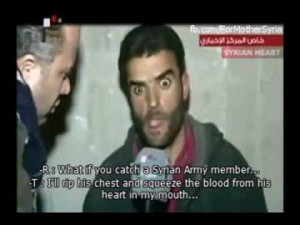So here’s a question: who remember’s Gaddafi’s claim back in 2011 that the jihadists and NATO-backed ‘rebels’ fighting to overthrow his government were feeding young Libyan men hallucinogenic drugs to fuel their violent activity?
“Bribed, drugged, and supporting the Devil…” was one of the late Gaddafi’s more colourful descriptions of the armed gangs that were terrorising the Libyan people in early 2011.
Based on subsequent evidence, that seems a rather pertinent description; and all the media commentators and journalists who made fun of him for saying it are now the ones with egg on their face. The utter absence of proper, investigative journalism or fact-finding in regard to Libya in 2011 was utterly astounding; which was one of the main reasons I wrote this book on the Libya catastrophe.
The story earlier this week that police in Lebanon had arrested a Saudi prince (identified by the media as Abdel Mohsen Bin Walid Bin Abdulaziz), on allegations he was attempting to smuggle two tonnes of amphetamines on his private jet, simply reinforced the reality that much of the rabid, ultra-violent jihadism we’ve seen from 2011 onwards has been linked to illegal drugs.
Four others were held in Beirut in what authorities described as a drug bust conducted at the city’s Rafik Hariri International Airport.
In this instance, investigators said they found 40 bags of Captagon Amphetamine pills and some cocaine aboard the plane, which had been about to depart for the northern Saudi city of Hael.
But this story immediately got me thinking back to Gaddafi, Libya, Syria and the rise of the so-called Islamic State group or ISIS.
Mainstream media commentators and journalists laughed at Gaddafi in 2011, dismissing his claims as the delusions or lies of an old man trying to cling to power. Yet evidence has since emerged from the fighting in Syria that many Syrian (and foreign) rebels were fuelled by illicit substances. Syrian rebels have been captured and video-recorded clearly in drug-induced frenzies and altered states: whether this explains some of the depravity of many of the rebels operating in Syria in those early stages of the Syrian Civil War (particularly in 2012/13) or whether they were just brutal, ultra-violent people anyway is difficult to say.
These are people, let’s remember, that were in some cases, among other things, beheading Syrian children and leaving their headless bodies in the street.
But it’s worth noting that most of the very worst and most brutal crimes of the various jihadists and militants operating in Syria occurred in the early months and the first year or so of the fighting: which was around the time jihadists and militants were flooding into Syria from the freshly fallen Libya in the now well-attested transfer of both weapons and jihadists that occurred in 2012 and was overseen by the CIA and the US State Department.
‘Captagon’, an amphetamine and psycho-stimulant said to be widely used in the Middle East but mostly unknown elsewhere, was reported to be keeping fighters (in Syria) on their feet during gruelling battles and generating money for more weapons. As this video attested, evidence was starting to emerge that the brutal conflict in Syria, despite having various causes, was also being fuelled by both the export and *consumption* of rapidly increasing quantities of illegal drugs.
Again, footage exists on-line of various Islamist militants, including Al-Qaeda, in Syria or Iraq where they are noticeably deranged: their behaviour and their mannerisms are visibly a type of ‘mania’. Remember Abu Sakkar, the crazed Syrian rebel who was filmed ripping the heart out of a Syrian soldier and eating it?
Reminiscent, it has to be said, of the ‘Libyan rebels’ who publicly tore out the internal organs of Libyan army soldiers in Misrata early in the 2011 uprising.

A scholarly analysis of ‘captagon’ in Saudi Arabia can be read here.
This recent seizure of amphetamines involving the Saudi prince in Lebanon is simply the latest tell-tale incident. Not very long ago, a reported shipment of around six-million captagon pills were seized, headed for ISIS/ISIL fighters in Syria, and the accusation was being made from multiple sources that NATO itself began production of the drug in a Bulgarian laboratory in 2011 – the very year of the Libyan and Syrian ‘uprisings’ – and that they are now also producing the drug elsewhere too.
By now, I would suggest we have enough evidence to suggest that these drugs have been driving much of the most ultra-violent terrorism since 2011, first in Libya, then Syria and Iraq, and that the drug has been steadily provided by agencies within NATO, Saudi Arabia and possibly other sources, from the very start.
Which, if true, would provide a very different context to some of the more inhuman, shocking behaviour of jihadists and extremists; including mass beheadings or, for example, the setting alight of the Jordanian pilot or even the sadistic rape and murder of Gaddafi himself in October 2011.
These substances and their proliferation would’ve, in all likelihood, been intended to create manic behaviour and possibly increased susceptibility to following morally-questionable orders.
It seems possible that some of the particularly barbaric crimes were being committed by people on these substances; though in truth many of those involved in the armed uprisings in Libya and Syria were simply brutal people anyway, as is the nature of most Salafist groups and is certainly the nature of Al-Qaeda. But considering how many of those who’s blood-lust was deliberately amplified and utilised for the purposes of the bloody revolutions in Libya and Syria then subsequently would’ve joined ISIL/Daesh either in Syria, Iraq or Libya, it tends to beg the question of whether ISIL itself owes more to drug-induced mania than it does to religious ideas.
In truth, probably an ugly and distinctly unholy mixture of both.

But Gaddafi, as with most of the rest of his explanations in 2011, has been proven absolutely correct.
He tried to explain right from the beginning that the Al-Qaeda leaders and operatives were giving young men free drugs and weapons and telling them to join in and that this was how the violent events of February 2011 unfolded so quickly and chaotically (read more here). What he presumably didn’t know was that the terrorists were probably getting their drugs and other supplies from the various governments (certainly including Saudi Arabia) who were invested in the downfall of Gaddafi and the Libyan state (and then Assad and the Syrian state).
This element of ‘Captagon’ in the violent jihadism from 2011 onwards (and, in turn, in the rise of ISIL/Daesh) is interesting for another reason too.
You will have heard numerous people over the last year or so compare ISIS to the Nazis or the SS in terms of their brutality and their fascistic ideology, right? Well, a German author and researcher, Norman Ohler, recently published a book in which he revealed a new dimension to the rise of the Nazis: specifically that Hitler’s armies had carried out their “Blitzkrieg” invasions of Poland and France while high on a version of crystal meth which kept them wide awake, feeling euphoric and invincible.

Norman Ohler reveals the key strategic role of the methamphetamine-based drug, manufactured from 1937 onwards by the Nazis under the brand name of “Pervitin” and distributed among the Nazi armed forces. According to these findings, based on months of research at military archives in Germany and the United States, the Nazi leadership was well aware of Pervitin’s value as stimulant during combat.
After having tried it in 1939 during the invasion of Poland, the German army subsequently ordered 35 million tablets of Pervitin for soldiers before advancing on France in the spring of 1940.
This invasion of France shocked the world at the time. In just four days, the radicalised and zealous Nazi forces had captured more French territory than German troops had managed to secure in four years of the First World War. ‘Pervitin’, it is now claimed, helped the invading Nazis stay awake, keep going and, apparently, “feel great”.
It’s true to say that ISIL/Daesh’s ‘lightning’ capturing of key Iraqi cities last year also ‘shocked the world’ in precisely the same way and was considered by most neutral observers as having been unprecedented.
Mr Ohler of course draws no parallels between the Nazis and ISIS; his research is purely historical. But when I saw this story, it was immediately obvious to me that there’s a clear parallel.
And given that the rise of the so-called ‘Islamic State’ has certainly been a cynically manufactured event for geo-political purposes, I tend to wonder if knowledge of how the Nazi soldiers proved so effective early on has been used as a blueprint of sorts for the early successes of the ISIL/Daesh terrorists and Islamo-Fascists.
The question being frequently asked last year of why the various Iraqi forces had been defeated ‘so quickly’ by the marauding ISIL hordes perhaps is a little easier to answer when we consider that those under-equipped and unprepared units found themselves under attack from hordes of insanely zealous jihadists who here high on psycho-stimulants, feeling utterly invincible and who were already known to be barbaric.
The drug-induced feelings of invincibility, as with Hitler’s troops and their lightning invasions, would also explain how these gangs of maniacs have been able to defeat the non-drug-taking Syrian Army and, earlier, the overwhelmed Libyan army soldiers. Gaddafi’s Libyan troops had had no idea what they were up against; no idea why all these insane youth were rampaging along with Al-Qaeda and other jihadists, no idea about the drugs or about the involvement of foreign intelligence agencies, until it was too late. Which is why Libyan soldiers were initially so quickly overrun and slaughtered in those earliest incidents in 2011. Assad’s Syrian troops at least had the benefit of foreknowledge because they’d watched what was happening in Libya first, which may be one of the reasons the Syrian conflict has gone on for five years whereas the initial Libyan conflict was over in a matter of months.
For more on Captagon and the Libyan uprising, download my (free) e-book ‘The Libya Conspiracy’ here.
As for this Saudi prince and this latest drug bust; isn’t drug-trafficking punishable by death in Saudi Arabia?
Not that I condone the death penalty in any country; but if you’re going to execute a teenage boy for attending a pro-democracy event when he was still technically a child, it seems to me a major drug dealer would surely have to be dealt with even more harshly…






Reblogged this on unbiasedsyndicate and commented:
And our MSM was bribed as well. I’m sure to keep this info under lock n key, makes me sick
Captagon was actually very popular in the West-German and West-Berlin drug and punk scene during the 1980s. It was easy to obtain through private prescription (where You pay for the drug yourself, opposed to normal prescreption, where the healthcare system pays for the drug). One would always find a doctor to write a private prescription, also these things could simply be forged. I can’t exactly remember when, I guess it was around 1986/87, the law changed on a number of drugs, including Captagon, so henceforth it was necessary to obtain a special prescription, since Captagon had been re-classified under the Betäubungsmittelgesetz (like Morphium, Opium, etc.), which was the end of Captagon as a „recreational“ drug in Germany.
In 1990 the owner of the West-German pharma company Imhausen, Jürgen Hippenstiel-Imhausen, nickname Hippie, was sentenced to five years in prison for providing Gaddaffi/Libya with components and chemistry for a facility in Rabta, which was declared to be a pharmaceutical plant, but was actually a production facility for nerve gas. As collateral results in this investigation it came out, that Imhausen had illegaly produced about 2,5 milllion tablets of MDMA for European and US-markets. Another manager was convicted for this. In the investigation it was also discovered, that Imhausen had produced millions of tablets of generic Captagon and delivered them to Lebanon. This however, had been a legal business.
The English language material I found is focussed on the poison gas facility.
http://www.nti.org/country-profiles/libya/facilities/
http://articles.latimes.com/1989-05-11/news/mn-3322_1_juergen-hippenstiel-imhausen-libya-poison-gas
About the drug end of the story there is plenty of material in German language, which can easily be found using „Jürgen Hippenstiel-Imhausen Libyen“ in an online search.
Captagon was actually very popular in the West-German and West-Berlin punk scene during the 1980s. It was easy to obtain through private prescription (where You pay for the drug yourself, opposed to normal prescreption, where the healthcare system pays for the drug). One would always find a doctor to write a private prescription, also these things could simply be forged. I can’t exactly remember when, I guess it was around 1986/87, the law changed on a number of drugs, including Captagon, so henceforth it was necessary to obtain a special prescription, since Captagon had been re-classified under the Betäubungsmittelgesetz (like Morphium, Opium, etc.), which was the end of Captagon as a „recreational“ drug in Germany.
In 1990 the owner of the West-German pharma company Imhausen, Jürgen Hippenstiel-Imhausen, nickname Hippie, was sentenced to five years in prison for providing Gaddaffi/Libya with components and chemistry for a facility in Rabta, which was declared to be a pharmaceutical plant, but was actually a production facility for nerve gas. As collateral results in this investigation it came out, that Imhausen had illegaly produced about 2,5 milllion tablets of MDMA for European and US-markets. Another manager was convicted for this. In the investigation it was also discovered, that Imhausen had produced millions of tablets of generic Captagon and delivered them to Lebanon. This however, had been a legal business.
English language material I found is focussed on the poison gas facility, no mentioning of the drug part.
http://www.nti.org/country-profiles/libya/facilities/
http://articles.latimes.com/1989-05-11/news/mn-3322_1_juergen-hippenstiel-imhausen-libya-poison-gas
About the drug end of the story there is plenty of material in German, which can easily be found using „Jürgen Hippenstiel-Imhausen Libyen“ in an online search.
Reblogged this on World Peace Forum.
Great piece….will be back often….chuq
btw the scholarly analysis of Captagon link doesnt seem to be working?
Oh, thanks for informing me, Vanessa. I can’t find the original link, but I think it’s the same as this document: http://www.moh.gov.sa/en/Sectors/PCCs/DMM/PCC_Information/Publications/Analysis%20of%20Captagon%20Tablets%20in%20Saudi%20Arabia.pdf
Reblogged this on Eyes on Europe & Middle East News.
Best analysis I have seen so far, sharing widely. 🙂
Thanks very much, Vanessa 🙂
I have just read your article – re Gaddafi etc. how very, very interesting.
What on earth is the outcome to this barbarism? – I worry a great deal for my grandchildren’s future.
Thanks Heather; I worry too for the future, all over the world. It’s astonishing to me the state of affairs we appear to have reached at this point in time, especially as someone who grew up in the 80s and early 90s when we had the end of the Cold War, the restoration of diplomacy and various peace-making initiatives going on and it seemed like the world was going to be a much safer, much more civilised place.